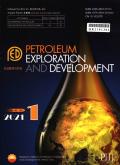Dynamic simulation of differential accumulation history of deep marine oil and gas in superimposed basin: A case study of Lower Paleozoic petroleum system of Tahe Oilfield, Tarim Basin, NW China
IF 7
Q1 ENERGY & FUELS
引用次数: 0
Abstract
According to the complex differential accumulation history of deep marine oil and gas in superposition basins, the Lower Paleozoic petroleum system in Tahe Oilfield of Tarim Basin is selected as a typical case, and the process of hydrocarbon generation and expulsion, migration and accumulation, adjustment and transformation of deep oil and gas is restored by means of reservoine-forming dynamics simulation. The thermal evolution history of the Lower Cambrian source rocks in Tahe Oilfield reflects the obvious differences in hydrocarbon generation and expulsion process and intensity in different tectonic zones, which is the main reason controlling the differences in deep oil and gas phases. The complex transport system composed of strike-slip fault and unconformity, etc. controlled early migration and accumulation and late adjustment of deep oil and gas, while the Middle Cambrian gypsum-salt rock in inner carbonate platform prevented vertical migration and accumulation of deep oil and gas, resulting in an obvious “fault-controlled” feature of deep oil and gas, in which the low potential area superimposed by the NE-strike-slip fault zone and deep oil and gas migration was conducive to accumulation, and it is mainly beaded along the strike-slip fault zone in the northeast direction. The dynamic simulation of reservoir formation reveals that the spatio-temporal configuration of “source-fault-fracture-gypsum-preservation” controls the differential accumulation of deep oil and gas in Tahe Oilfield. The Ordovician has experienced the accumulation history of multiple periods of charging, vertical migration and accumulation, and lateral adjustment and transformation, and deep oil and gas have always been in the dynamic equilibrium of migration, accumulation and escape. The statistics of residual oil and gas show that the deep stratum of Tahe Oilfield still has exploration and development potential in the Ordovician Yingshan Formation and Penglaiba Formation, and the Middle and Upper Cambrian ultra-deep stratum has a certain oil and gas resource prospect. This study provides a reference for the dynamic quantitative evaluation of deep oil and gas in the Tarim Basin, and also provides a reference for the study of reservoir formation and evolution in carbonate reservoir of paleo-craton basin.
叠加盆地深海油气差异累积历史动态模拟:中国西北部塔里木盆地塔河油田下古生界石油系统案例研究
根据叠合盆地深层海相油气复杂的差异积聚历史,选取塔里木盆地塔河油田下古生界石油系统作为典型案例,通过成藏动力学模拟还原了深层油气的生烃驱烃、运移积聚、调整转化过程。塔河油田下寒武统源岩的热演化历史反映了不同构造带烃生成、排出过程和强度的明显差异,是控制深层油气物相差异的主要原因。由走向-滑动断层和不整合等组成的复杂运移体系中寒武统石膏盐岩在碳酸盐岩平台内部阻止了深层油气的垂直运移和聚集,形成了明显的深层油气 "断裂控制 "特征,其中东北向走向断裂带与深层油气运移叠加的低势区有利于聚集,主要沿东北向走向断裂带呈串珠状分布。储层形成动态模拟揭示了 "源-断层-断裂-石膏-保存 "的时空构造控制着塔河油田深层油气的差异聚集。奥陶系经历了多期充注、垂直运移堆积、横向调整转化的堆积历史,深层油气始终处于运移、堆积、逸出的动态平衡之中。残余油气统计表明,塔河油田深部地层奥陶系英山组、蓬莱坝组仍具有勘探开发潜力,中、上寒武统超深部地层具有一定的油气资源远景。该研究为塔里木盆地深层油气动态定量评价提供了参考,也为古克拉通盆地碳酸盐岩储层形成与演化研究提供了借鉴。
本文章由计算机程序翻译,如有差异,请以英文原文为准。
求助全文
约1分钟内获得全文
求助全文

 求助内容:
求助内容: 应助结果提醒方式:
应助结果提醒方式:


